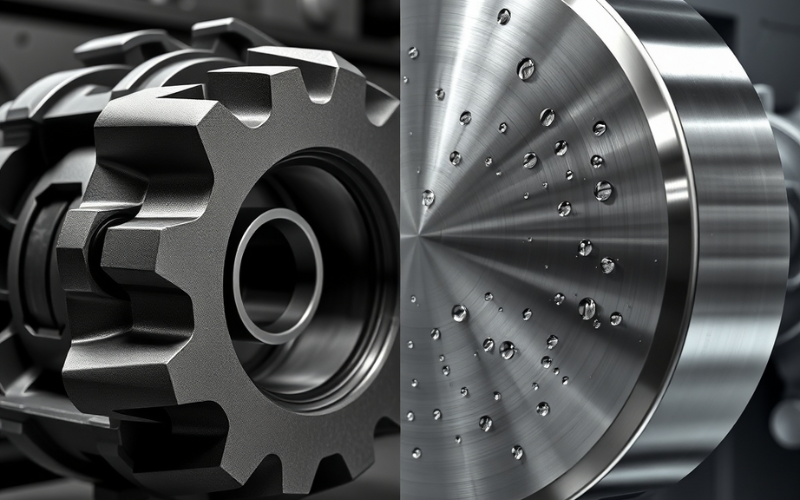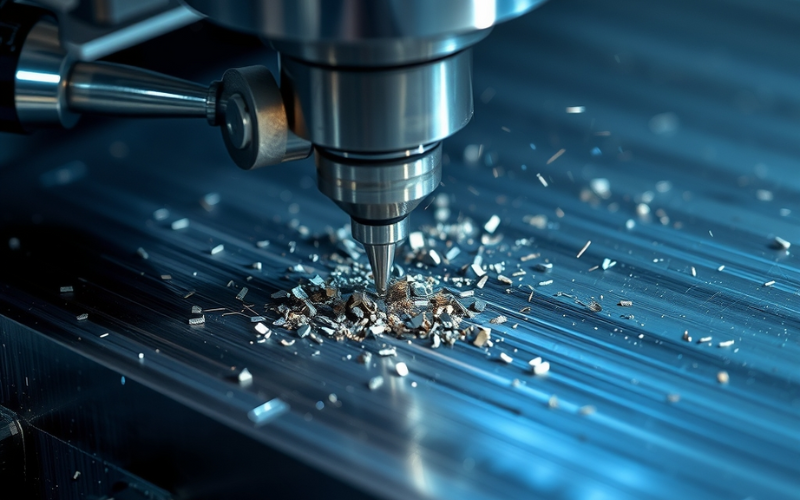Let Istar help you get started on your project with our experience and know-how!
Upload your design files and production requirements and we will get back to you within 30 minutes!

Not all steel is the same. Knowing the difference between kinds of steel, like alloy steel and stainless steel, is important for doing a good job. This article will help you see this important difference. I will tell you what makes each kind of steel special. You will learn their good points, bad points, and what they are good for.
When we talk about steel, we are often talking about a mix of iron and carbon. But to give it special abilities, other things are added. This is how we get alloy steel and stainless steel. Think of it like baking a cake. The main recipe is flour and sugar (iron and carbon). But you can add other things to change the cake in a big way.
The main difference between alloy steel and stainless steel is the other parts added, which we call alloying elements. An alloy steel is a kind of steel that has small bits of one or more alloying elements mixed in. These can be manganese, nickel, molybdenum, and vanadium. These parts give the alloy steel better mechanical properties, like more strength and durability.
Stainless steel is a special kind of high alloy steel. Its most important part is chromium. To be called stainless steel, a steel needs to have at least 10.5% chromium. This large amount of chromium is what gives stainless steel its well-known power to fight corrosion and rust. The chromium makes a thin layer you can’t see on the top of the steel that keeps it safe. This layer is called a chromium oxide layer. So, even though all stainless steel is a kind of alloy steel, not all alloy steel is stainless steel. The main difference is the large amount of chromium in stainless steel that stops corrosion.
One of the biggest questions people ask is about rust. Will my steel project turn brown and fall apart over time? The answer is based on the type of steel you pick. The power of a steel to fight rust is called corrosion resistance. When you look at alloy steel vs stainless steel, there is a clear winner here.
Stainless steel is the best at corrosion resistance. Like I said, the large amount of chromium (at least 10.5%) in stainless steel makes a safe layer. This layer stops water and air from getting to the iron inside the steel, which stops rust from starting. This makes stainless steel the best choice for jobs in wet places, like kitchens, bathrooms, or boats. It gives excellent corrosion resistance.
What about alloy steel? Regular alloy steel does not have this much chromium. Some alloying elements can make its corrosion resistance a little better, but it will probably rust more than stainless steel. This does not make alloy steel bad. It just means it is not the best choice for places that get wet a lot. If you use alloy steel outside or in a wet spot, you will probably have to paint it or add a special covering to keep it safe from corrosion. So, when you think about alloy and stainless, know that stainless steel is your best choice for fighting rust.
When I think of a strong material, I think about its hardness and toughness. Hardness is its power to stop from getting scratched or dented. Toughness is its power to take a hit without breaking. These are important mechanical properties to think about. A lot of people ask, is alloy steel harder than stainless steel? The answer is most of the time, yes.
Most of the time, alloy steel is known for being stronger and having more hardness than stainless steel. By adding parts like manganese, molybdenum, and vanadium, we can make alloy steel very strong and tough. This is why alloy steel is used for hard jobs. Think of gears in a car, the landing parts on a plane, or strong tools. These things need high strength and durability, and alloy steel gives them that. The tensile strength of alloy steels compared to stainless steel is usually much higher. Tensile strength shows how much pull something can take before it breaks.
Stainless steel is a strong steel, but it is usually not as hard as alloy steel. Its main purpose is to stop corrosion, not to be the very strongest steel you can get. But, there are different types of stainless steel, and some are stronger than others. For example, a type called martensitic stainless steel can be heat-treated to get very hard. But when you compare stainless steel vs alloy steel side by side, alloy steel usually wins for hardness and strength-to-weight ratio.

I have learned that not all stainless steel is the same. Like there are many kinds of apples, there are many types of stainless steel. They are put in groups based on what they are like on the inside. The four main kinds are austenitic, ferritic, martensitic, and duplex.
Here is a simple table to show the main types of stainless steel:
| Type of Stainless Steel | Key Things | Common Uses |
|---|---|---|
| Austenitic | Most common type. Very good corrosion resistance. Easy to shape. Not magnetic. | Kitchen sinks (304 grade), food processing equipment, chemical storage tanks. |
| Ferritic | Good corrosion resistance. Magnetic. Costs less than austenitic. | Car exhaust systems, dishwashers, trim on buildings. |
| Martensitic | Can be made very hard with heat. Good wear resistance. Magnetic. | Knives, doctor’s tools, valves, tools. |
| Duplex | A mix of austenitic and ferrite. Very high strength. Very good corrosion resistance. | Paper making, boat parts, structural components. |
The most common stainless steel you will find is austenitic stainless steel, like grade 304. It has a good mix of corrosion resistance, being easy to shape, and cost. When a job needs even more corrosion resistance, like against salt, grade 316, which has molybdenum, is a better choice. Ferritic stainless steel is a good, cheaper choice when very high corrosion resistance is not needed. Martensitic steel is picked for its hardness, and duplex stainless steel is used for the hardest jobs that need both high strength and corrosion resistance.
Picking the right steel for your job means looking hard at its mechanical properties. I have learned this is more than just asking “is it strong?” It is about finding the right match for the needs of your job with the properties of the material for your project. Let’s look at some main properties when comparing alloy steel and stainless steel.
Here are some important properties to think about:
Knowing these mechanical properties helps you make a good choice. You do not always need the strongest or hardest steel. Sometimes, corrosion resistance and aesthetic appeal (how good it looks) are more important. It is all about finding the right mix for what you need.
The special things about alloy steel and stainless steel make them good for very different jobs. I have seen them used in many kinds of work. Thinking about the common applications can help you pick which type of steel is the best steel for you.
Alloy steel is the usual choice when strength, hardness, and wear resistance are the most important things. Its high strength makes it great for the automotive industry, where it is used to make strong parts like crankshafts, gears, and axles. You will also find alloy steel in:
Stainless steel, on the other hand, is picked when corrosion resistance, being clean, and how it looks matter most. Its shiny, clean look and its power to fight rust make it great for many uses. The most common applications for stainless steel are:
So, when choosing between alloy and stainless steel, think about the job. Do you need something strong for an engine? Pick alloy steel. Do you need something clean for a kitchen? Stainless steel is the better option.

I always tell people to think about the whole life of their job, not just the price of the material. When you look at the cost of alloy steel and stainless steel, it is important to check both the first price and the costs over time.
Most of the time, alloy steel has a lower first cost than stainless steel. The parts used to make alloy steel cost less than the large amount of chromium and often nickel in stainless steel. So, for jobs with a small amount of money where great corrosion resistance is not needed, alloy steel can look like the cheaper choice.
But, stainless steel often has a lower cost over time, especially in some places. Because of its excellent corrosion resistance, stainless steel does not need much care. You do not need to paint it or put special coverings on it to keep it from rust. An alloy steel part used outside might have to be changed or fixed up many times over the years, which makes the total cost higher. A stainless steel part in the same spot could last for many years with very little care. This durability makes the higher initial cost of stainless steel a good choice for the future for many jobs.
So, which is the better option? If the part will be in a dry, safe place and strength is important, alloy steel might save you money. But if the part will be around water, chemicals, or outside, the low maintenance requirements and long life of stainless steel often make it the choice that saves more money over time.
Over the years, I have made a list to help me pick the right material for my jobs. When you are picking between alloy steel and stainless steel, asking the right questions can save you time, money, and problems. The final choice between alloy vs steel always depends on the small things about your job.
Here are the main things I consider when choosing:
By thinking about these points, you can make a smart choice. The plan is to pick the steel that works well, lasts a long time, and is a price you can pay.
The way a steel is made and handled can change what it is like in a big way. I have learned that you can’t just pick a type of steel; you also have to think about how it is handled. This is very true for alloy steel, which gets many of its best good points from heat treatment.
Many alloy steels are made to be heat-treated. This is done by heating the steel to a high heat and then cooling it down in a certain way. This can make the hardness, strength, and toughness of the steel alloy much bigger. For example, a way of doing this can turn a good alloy steel into a very strong and long-lasting material. This power to change what it’s like through heat treatment is a big plus for alloy steel.
Stainless steel can also be handled, but the way it’s done and the results are different for each type. Austenitic stainless steels (like 304) cannot be made harder by heat treatment. They get harder when they are cold-worked, which is shaping them when they are not hot. Martensitic stainless steels, on the other hand, are like alloy steels because they can be made much harder with a heat-treat process. Knowing these differences is important for people who design and make parts that need to be a certain way. The journey of making a steel is just as important as what it’s made of at the start.
I have given you a lot of facts about the differences between alloy steel and stainless steel. It might feel like a lot, but picking the right steel is really about a few main ideas. I have made mistakes by picking the wrong material for your project, and I want to help you not do that.
Let’s do a last check. Before you pick, remember the main differences between alloy steel and stainless steel. Alloy steel is your best choice for strength and durability. It’s tough, hard, and can be heat-treated to get even stronger. It is usually the cheaper choice at the start. But, it can be harmed by corrosion and might need to be protected.
Stainless steel’s special power is its great corrosion resistance, because of all that chromium. It’s the material you want for wet, damaging, or clean places. It’s also nice to look at, with a clean, new look. It costs more at first, but its long life and low care can save you money in the end. The choice of stainless steel vs alloy is all about the needs of your job.
Here are the most important things to remember when picking between alloy steel and stainless steel: